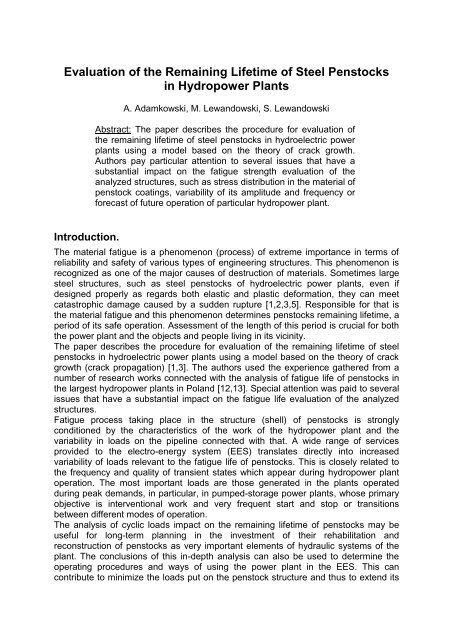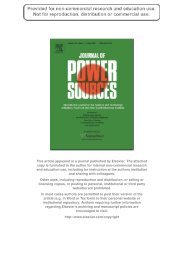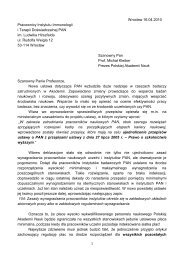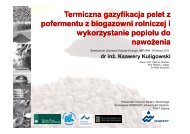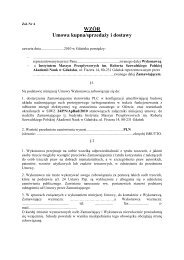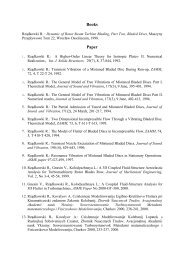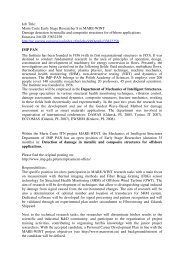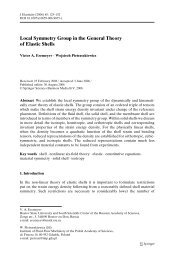Evaluation of the Remaining Lifetime of Steel Penstocks in ...
Evaluation of the Remaining Lifetime of Steel Penstocks in ...
Evaluation of the Remaining Lifetime of Steel Penstocks in ...
Create successful ePaper yourself
Turn your PDF publications into a flip-book with our unique Google optimized e-Paper software.
<strong>Evaluation</strong> <strong>of</strong> <strong>the</strong> <strong>Rema<strong>in</strong><strong>in</strong>g</strong> <strong>Lifetime</strong> <strong>of</strong> <strong>Steel</strong> <strong>Penstocks</strong><strong>in</strong> Hydropower PlantsA. Adamkowski, M. Lewandowski, S. LewandowskiAbstract: The paper describes <strong>the</strong> procedure for evaluation <strong>of</strong><strong>the</strong> rema<strong>in</strong><strong>in</strong>g lifetime <strong>of</strong> steel penstocks <strong>in</strong> hydroelectric powerplants us<strong>in</strong>g a model based on <strong>the</strong> <strong>the</strong>ory <strong>of</strong> crack growth.Authors pay particular attention to several issues that have asubstantial impact on <strong>the</strong> fatigue strength evaluation <strong>of</strong> <strong>the</strong>analyzed structures, such as stress distribution <strong>in</strong> <strong>the</strong> material <strong>of</strong>penstock coat<strong>in</strong>gs, variability <strong>of</strong> its amplitude and frequency orforecast <strong>of</strong> future operation <strong>of</strong> particular hydropower plant.Introduction.The material fatigue is a phenomenon (process) <strong>of</strong> extreme importance <strong>in</strong> terms <strong>of</strong>reliability and safety <strong>of</strong> various types <strong>of</strong> eng<strong>in</strong>eer<strong>in</strong>g structures. This phenomenon isrecognized as one <strong>of</strong> <strong>the</strong> major causes <strong>of</strong> destruction <strong>of</strong> materials. Sometimes largesteel structures, such as steel penstocks <strong>of</strong> hydroelectric power plants, even ifdesigned properly as regards both elastic and plastic deformation, <strong>the</strong>y can meetcatastrophic damage caused by a sudden rupture [1,2,3,5]. Responsible for that is<strong>the</strong> material fatigue and this phenomenon determ<strong>in</strong>es penstocks rema<strong>in</strong><strong>in</strong>g lifetime, aperiod <strong>of</strong> its safe operation. Assessment <strong>of</strong> <strong>the</strong> length <strong>of</strong> this period is crucial for both<strong>the</strong> power plant and <strong>the</strong> objects and people liv<strong>in</strong>g <strong>in</strong> its vic<strong>in</strong>ity.The paper describes <strong>the</strong> procedure for evaluation <strong>of</strong> <strong>the</strong> rema<strong>in</strong><strong>in</strong>g lifetime <strong>of</strong> steelpenstocks <strong>in</strong> hydroelectric power plants us<strong>in</strong>g a model based on <strong>the</strong> <strong>the</strong>ory <strong>of</strong> crackgrowth (crack propagation) [1,3]. The authors used <strong>the</strong> experience ga<strong>the</strong>red from anumber <strong>of</strong> research works connected with <strong>the</strong> analysis <strong>of</strong> fatigue life <strong>of</strong> penstocks <strong>in</strong><strong>the</strong> largest hydropower plants <strong>in</strong> Poland [12,13]. Special attention was paid to severalissues that have a substantial impact on <strong>the</strong> fatigue life evaluation <strong>of</strong> <strong>the</strong> analyzedstructures.Fatigue process tak<strong>in</strong>g place <strong>in</strong> <strong>the</strong> structure (shell) <strong>of</strong> penstocks is stronglyconditioned by <strong>the</strong> characteristics <strong>of</strong> <strong>the</strong> work <strong>of</strong> <strong>the</strong> hydropower plant and <strong>the</strong>variability <strong>in</strong> loads on <strong>the</strong> pipel<strong>in</strong>e connected with that. A wide range <strong>of</strong> servicesprovided to <strong>the</strong> electro-energy system (EES) translates directly <strong>in</strong>to <strong>in</strong>creasedvariability <strong>of</strong> loads relevant to <strong>the</strong> fatigue life <strong>of</strong> penstocks. This is closely related to<strong>the</strong> frequency and quality <strong>of</strong> transient states which appear dur<strong>in</strong>g hydropower plantoperation. The most important loads are those generated <strong>in</strong> <strong>the</strong> plants operateddur<strong>in</strong>g peak demands, <strong>in</strong> particular, <strong>in</strong> pumped-storage power plants, whose primaryobjective is <strong>in</strong>terventional work and very frequent start and stop or transitionsbetween different modes <strong>of</strong> operation.The analysis <strong>of</strong> cyclic loads impact on <strong>the</strong> rema<strong>in</strong><strong>in</strong>g lifetime <strong>of</strong> penstocks may beuseful for long-term plann<strong>in</strong>g <strong>in</strong> <strong>the</strong> <strong>in</strong>vestment <strong>of</strong> <strong>the</strong>ir rehabilitation andreconstruction <strong>of</strong> penstocks as very important elements <strong>of</strong> hydraulic systems <strong>of</strong> <strong>the</strong>plant. The conclusions <strong>of</strong> this <strong>in</strong>-depth analysis can also be used to determ<strong>in</strong>e <strong>the</strong>operat<strong>in</strong>g procedures and ways <strong>of</strong> us<strong>in</strong>g <strong>the</strong> power plant <strong>in</strong> <strong>the</strong> EES. This cancontribute to m<strong>in</strong>imize <strong>the</strong> loads put on <strong>the</strong> penstock structure and thus to extend its
safe operation, or, <strong>in</strong> some cases, to allow power plants to conditionally cont<strong>in</strong>ue itsoperat<strong>in</strong>g.Theoretical basis (fundamentals) <strong>of</strong> <strong>the</strong> crack growth model.Predict<strong>in</strong>g <strong>the</strong> course <strong>of</strong> material fatigue is a complex issue and, moreover, it ispresent<strong>in</strong>g <strong>the</strong> high uncerta<strong>in</strong>ty <strong>of</strong> calculation results. The rich literature concern<strong>in</strong>g<strong>the</strong> evaluation <strong>of</strong> fatigue life <strong>of</strong> materials, is full <strong>of</strong> many hypo<strong>the</strong>ses, which are <strong>the</strong>bases <strong>of</strong> models used for describ<strong>in</strong>g <strong>the</strong> process <strong>of</strong> fatigue [1,2,3,4,5,8,9].Unfortunately, with <strong>the</strong> diversity <strong>of</strong> <strong>the</strong>se hypo<strong>the</strong>ses, large variations <strong>of</strong> <strong>the</strong> resultsobta<strong>in</strong>ed us<strong>in</strong>g <strong>the</strong> same <strong>in</strong>put data is also characteristic. Hence, <strong>the</strong> proper selection<strong>of</strong> <strong>the</strong> model to <strong>the</strong> analysed system exposed at variable loads is very important withrespect to <strong>the</strong> characteristics <strong>of</strong> <strong>the</strong> material and design <strong>of</strong> that system as well as to<strong>the</strong> variability <strong>of</strong> <strong>the</strong> loads (amplitude, frequency).A model based on <strong>the</strong> <strong>the</strong>ory <strong>of</strong> crack growth was chosen for evaluat<strong>in</strong>g <strong>the</strong> lifetime<strong>of</strong> steel penstocks <strong>in</strong> hydropower plants. Solid <strong>the</strong>oretical foundations based on <strong>the</strong>physics <strong>of</strong> <strong>the</strong> fatigue fracture <strong>of</strong> <strong>the</strong> material and common use <strong>of</strong> this model <strong>in</strong>technical applications was a direct reason for this choice.Assumption that sudden fracture is caused by an <strong>in</strong>crease <strong>of</strong> <strong>the</strong> microcracks exist<strong>in</strong>g<strong>in</strong> <strong>the</strong> material underlies <strong>the</strong> model used. These microcracks, exposed on someloads (stresses), <strong>in</strong>crease until <strong>the</strong>y become unstable what leads to a catastrophicrupture <strong>of</strong> <strong>the</strong> penstock. Bas<strong>in</strong>g on known criteria we can determ<strong>in</strong>e <strong>the</strong> criticalmagnitude <strong>of</strong> <strong>the</strong> load, which do not yet cause <strong>the</strong> sudden rupture <strong>of</strong> <strong>the</strong> material.However, for significant variability <strong>of</strong> <strong>the</strong> loads or presence <strong>of</strong> different materialimperfections (e.g. corrosion) <strong>the</strong> crack growth accompany<strong>in</strong>g <strong>the</strong> fatigue processcan be caused even by stresses lower than <strong>the</strong> yield stress.Durability <strong>of</strong> almost every large welded structure (weldment) should be assessedbas<strong>in</strong>g on <strong>the</strong> crack growth process. Such structures are always characterized by <strong>the</strong>presence <strong>of</strong> cracks, which are not detected dur<strong>in</strong>g <strong>the</strong> tests and <strong>in</strong>spections due to<strong>the</strong>ir small size (microcracks). The condition for sudden fracture <strong>in</strong>itiation has <strong>the</strong>follow<strong>in</strong>g, general form for various types <strong>of</strong> structures [1,3]:S a EG c(1)This condition says that <strong>the</strong> sudden fracture occurs <strong>in</strong> <strong>the</strong> material exposed to cyclicloads (stresses) with <strong>the</strong> amplitude <strong>of</strong> S, if exist<strong>in</strong>g cracks reach a critical value <strong>of</strong><strong>the</strong>ir l<strong>in</strong>ear dimension a, or alternatively, if <strong>the</strong> material with cracks characterized bycerta<strong>in</strong> value <strong>of</strong> a is exposed at loads caus<strong>in</strong>g stress amplitude S.Expression S ais <strong>of</strong>ten replaced by a quantity K called stress <strong>in</strong>tensity factor,and Eq.(1) can be than formulated as follows:whereIcc K K IcK EG is a critical stress <strong>in</strong>tensity factor (E stands for Young’s modulus,G – for a critical speed <strong>of</strong> energy release required to form a crack with <strong>the</strong> unitsurface, also called toughness). The phenomenon <strong>of</strong> sudden fracture occurs whenK K Ic . .
Stress <strong>in</strong>crease, represented <strong>in</strong> Eq.1 by S, relates to fragments <strong>of</strong> <strong>the</strong> analyzedstructure characterized by a regular shape, with no significant geometricalimperfections responsible for <strong>the</strong> stress concentration. However it is obvious, thatthose components <strong>of</strong> <strong>the</strong> structure which are characterized by <strong>the</strong> highest stressconcentration have a critical impact on <strong>the</strong> durability <strong>of</strong> this structure. Therefore, <strong>the</strong>shape factor is <strong>in</strong>troduced <strong>in</strong>to Eq.1 (also called <strong>the</strong> stress concentration coefficient,or <strong>the</strong>oretical notch effect factor) k def<strong>in</strong>ed as k maxn , where n stands for<strong>the</strong> nom<strong>in</strong>al stress (<strong>in</strong> <strong>the</strong> absence <strong>of</strong> a notch, irregularities, imperfections, etc.) and max stands for <strong>the</strong> maximum stress.Beside <strong>the</strong> external load and <strong>the</strong> crack dimensions as well as <strong>the</strong> stressconcentration coefficient k , also geometry <strong>of</strong> <strong>the</strong> elements and <strong>the</strong> shape <strong>of</strong> crackshave significant <strong>in</strong>fluence on <strong>the</strong> value <strong>of</strong> <strong>the</strong> factor K. This impact is taken <strong>in</strong>toaccount us<strong>in</strong>g <strong>the</strong> coefficient <strong>of</strong> f<strong>in</strong>ite dimensions and crack shape M k. Therefore, for<strong>the</strong> elements with irregularities (imperfections) and tak<strong>in</strong>g <strong>the</strong> factor <strong>of</strong> M k <strong>in</strong>toconsideration , K can be expressed as follows: K M Sa(2)k<strong>Evaluation</strong> <strong>of</strong> <strong>the</strong> safe operation period <strong>of</strong> <strong>the</strong> construction requires specify<strong>in</strong>g <strong>the</strong>number <strong>of</strong> load cycles N that can happen without caus<strong>in</strong>g catastrophic growth <strong>of</strong>exist<strong>in</strong>g cracks and damage <strong>of</strong> <strong>the</strong> analysed structure. The value <strong>of</strong> N, correspond<strong>in</strong>gto <strong>the</strong> length or depth <strong>of</strong> <strong>the</strong> crack a, can be calculated us<strong>in</strong>g <strong>the</strong> Paris and Erdoganequation def<strong>in</strong><strong>in</strong>g <strong>the</strong> fatigue crack growth as follows [1,3]:kdadNm C K(3)where C and m are material constants characteriz<strong>in</strong>g <strong>the</strong> analyzed structure.If <strong>the</strong> <strong>in</strong>itial a 0 and f<strong>in</strong>al a c values <strong>of</strong> crack length or depth are known , (a c is <strong>the</strong> criticaldimension at which <strong>the</strong> cracks becomes unstable and grow rapidly – it correspondsto <strong>the</strong> critical stress <strong>in</strong>tensity factor K Ic ) <strong>the</strong>n <strong>the</strong> safe number <strong>of</strong> cycles N c can becalculated by <strong>in</strong>tegrat<strong>in</strong>g Eq.3:Nca ca0daC(K)m(4)It has to be emphasized that no general <strong>the</strong>ory describ<strong>in</strong>g <strong>the</strong> crack growth process<strong>in</strong> materials was formulated so far, and <strong>the</strong> Paris-Erdogan equation, like <strong>the</strong> most <strong>of</strong>such equations presented <strong>in</strong> <strong>the</strong> literature, is an example <strong>of</strong> <strong>the</strong> approximaterelationship obta<strong>in</strong>ed experimentally. Therefore, assessment <strong>of</strong> <strong>the</strong> safe operationtime <strong>of</strong> <strong>the</strong> construction, based on Eq.4, must be conducted tak<strong>in</strong>g <strong>in</strong>to considerationconstra<strong>in</strong>ts posed by <strong>the</strong> use <strong>of</strong> empirical data and formulas.The model based on <strong>the</strong> <strong>the</strong>ory <strong>of</strong> crack growth makes <strong>the</strong> crack growth ratedependent on several factors, among which <strong>the</strong> most important are: The range <strong>of</strong> stress changes: S S max Sm<strong>in</strong>; The coefficient <strong>of</strong> asymmetry <strong>of</strong> stress cycle: R S m<strong>in</strong>Smax;
The complexity <strong>of</strong> <strong>the</strong> stress state (variation amplitude, multiaxis); Mechanical properties <strong>of</strong> <strong>the</strong> material (eg, yield stress, elasticity); Metallurgical factors (such as alloy composition, heat treatment); Environmental factors (eg temperature, humidity, radiation); Geometry <strong>of</strong> <strong>the</strong> analyzed structure.The first two factors, S and R, are <strong>of</strong> particularly importance. These factorscharacterize vary<strong>in</strong>g loads affect<strong>in</strong>g <strong>the</strong> penstock. Usually it is ra<strong>the</strong>r problematic andtime consum<strong>in</strong>g to take <strong>in</strong>to account stress courses that are complex and diversified<strong>in</strong> terms <strong>of</strong> amplitude and frequency. The problem <strong>of</strong> calculat<strong>in</strong>g <strong>the</strong> alternative(equivalent) values <strong>of</strong> <strong>the</strong>se changes will be presented below <strong>in</strong> this paper.Range <strong>of</strong> stress changes essential for evaluation <strong>of</strong> penstocklifetimeIn each hydrounits mode <strong>of</strong> operation <strong>in</strong> hydropower plant <strong>the</strong> construction <strong>of</strong>penstocks are exposed at loads <strong>of</strong> different <strong>in</strong>tensity <strong>of</strong> <strong>the</strong>ir changes. Depend<strong>in</strong>g onmany factors, such as <strong>the</strong> k<strong>in</strong>d <strong>of</strong> mode <strong>of</strong> operation or <strong>the</strong> type <strong>of</strong> transition staterealized by hydrounits, <strong>the</strong> cycles <strong>of</strong> <strong>the</strong>se load changes are characterized by vary<strong>in</strong>gamplitude and frequency <strong>of</strong> stresses. The <strong>the</strong>ory <strong>of</strong> crack growth, as alreadymentioned, assumes that <strong>in</strong> <strong>the</strong> material <strong>of</strong> <strong>the</strong> analyzed structure <strong>the</strong>re are someprimary cracks and <strong>the</strong>ir existence is not connected with <strong>the</strong> operational conditions <strong>of</strong><strong>the</strong> construction. One <strong>of</strong> <strong>the</strong> ma<strong>in</strong> characteristics <strong>of</strong> <strong>the</strong>se cracks is <strong>the</strong>ir dimensions(length or depth), which decides whe<strong>the</strong>r a given stress change will cause fur<strong>the</strong>rgrowth <strong>of</strong> <strong>the</strong>se cracks. Briefly put, if <strong>the</strong> primary microcrack <strong>of</strong> a given dimension a isexposed at too small stress change S, <strong>the</strong>n it will not <strong>in</strong>crease. Only sufficientlylarge stress change, not less than a threshold value S th can cause primarymicrocracks grow<strong>in</strong>g <strong>in</strong> <strong>the</strong> material <strong>of</strong> <strong>the</strong> construction.The Paris-Erdogan formula confirms this <strong>the</strong>ory. It does not recognize <strong>the</strong> full course<strong>of</strong> crack<strong>in</strong>g, and concerns <strong>the</strong> range <strong>of</strong> changes <strong>in</strong> <strong>the</strong> value <strong>of</strong> K above a certa<strong>in</strong>value K th , called <strong>the</strong> threshold stress <strong>in</strong>tensity factor, to <strong>the</strong> critical value K Ic at which<strong>the</strong> damage <strong>of</strong> <strong>the</strong> analyzed material ensues. It is assumed that when <strong>the</strong> stress<strong>in</strong>tensity factor is lower than <strong>the</strong> value <strong>of</strong> K th cracks does not develop, regardless <strong>of</strong><strong>the</strong> prior load state. That means that <strong>the</strong> quantity K th represents a sort <strong>of</strong> a safetyfactor if consider<strong>in</strong>g crack growth. Knowledge <strong>of</strong> its value allows to specify which <strong>of</strong><strong>the</strong> variable loads have an <strong>in</strong>fluence on <strong>the</strong> crack growth <strong>in</strong> <strong>the</strong> material <strong>of</strong> <strong>the</strong>analyzed structure.Load cycles <strong>in</strong> penstocks <strong>of</strong> hydropower plants and <strong>the</strong>ir equivalentcharacteristicsThe Eq.3, as well as o<strong>the</strong>r formulas similar to it presented <strong>in</strong> <strong>the</strong> literature, relate tostress changes with constant amplitude. It does not recognize <strong>the</strong> effects related toirregularity <strong>of</strong> stress changes which characterizes <strong>the</strong> vast majority <strong>of</strong> eng<strong>in</strong>eer<strong>in</strong>gstructures <strong>in</strong> operation. In <strong>the</strong> case <strong>of</strong> penstocks <strong>in</strong> hydropower plants <strong>the</strong> load cyclescan have considerably vary<strong>in</strong>g amplitude as well as frequency. The ma<strong>in</strong> reason for<strong>the</strong>se loads is transient states, realized at hydrounits whose effects are spreadthroughout <strong>the</strong> whole flow system. In this case, <strong>the</strong> load characteristics dependma<strong>in</strong>ly on how <strong>the</strong> hydroelectric power station is used <strong>in</strong> <strong>the</strong> EES. Configuration <strong>of</strong>this system and nature <strong>of</strong> <strong>the</strong> volatility <strong>in</strong> demands for power and energy decide how
many starts and stops are realized, how frequent and fast are load changes, and alsohow frequent are transitions between different operational modes <strong>of</strong> hydrounits.Among many well-known types <strong>of</strong> hydropower plants, pumped-storage power plantsare characterized by <strong>the</strong> most diversified operation, and hence various loads exertedon flow elements <strong>of</strong> hydraulic systems. It is closely dependent on <strong>the</strong> reversiblehydrounits which are common equipments <strong>of</strong> such power plants and <strong>the</strong> way that<strong>the</strong>y are used by <strong>the</strong> power plant operator or <strong>the</strong> transmission system operator. Thetransient states result<strong>in</strong>g from <strong>the</strong> follow<strong>in</strong>g transitions between some operationmodes and emergency conditions <strong>of</strong> hydrounit are <strong>the</strong> most important for lifetimeanalysis <strong>of</strong> penstocks: normal start and stop at:o turb<strong>in</strong>e or pump<strong>in</strong>g mode <strong>of</strong> operation,o compensator mode with turb<strong>in</strong>e direction <strong>of</strong> rotation; emergency shutdown from <strong>the</strong> turb<strong>in</strong>e and pump modes <strong>of</strong> operation; transitions between:o compensator mode and turb<strong>in</strong>e mode <strong>of</strong> operation,o turb<strong>in</strong>e mode and compensator mode <strong>of</strong> operation,o compensator mode and pump mode <strong>of</strong> operation.Additionally, <strong>the</strong>re should still be taken <strong>in</strong>to account fill<strong>in</strong>g and empty<strong>in</strong>g <strong>the</strong> penstockthat usually causes <strong>the</strong> greatest <strong>in</strong>crease <strong>in</strong> stress <strong>in</strong> <strong>the</strong> pipel<strong>in</strong>e coat<strong>in</strong>g.Each <strong>of</strong> <strong>the</strong> aforementioned transient states is characterized by differentcharacteristics <strong>of</strong> <strong>the</strong> loads generated <strong>in</strong> hydraulic system. Among <strong>the</strong>m follow<strong>in</strong>gshould be dist<strong>in</strong>guished: states with one or two important cycles <strong>of</strong> pressure and stress changes (eg,fill<strong>in</strong>g / empty<strong>in</strong>g <strong>the</strong> penstock, start <strong>of</strong> turb<strong>in</strong>e or pump mode <strong>of</strong> operation),with one or two pairs <strong>of</strong> maxima and m<strong>in</strong>ima <strong>in</strong> <strong>the</strong>se changes – e.g. Figure 1states with multicycles <strong>of</strong> pressure and stress changes (such as normal stopsfrom <strong>the</strong> pump<strong>in</strong>g mode or emergency shutdowns from <strong>the</strong> turb<strong>in</strong>e/pump<strong>in</strong>gmode <strong>of</strong> operation), with damp<strong>in</strong>g phase <strong>of</strong> free oscillations after one- or twophasechange <strong>of</strong> pressure and stress – e.g. Figure 2As it was mentioned earlier, <strong>the</strong> analysis <strong>of</strong> fatigue life requires knowledge about <strong>the</strong>material and geometric data <strong>of</strong> <strong>the</strong> analyzed structures as well as <strong>the</strong> appropriatedeterm<strong>in</strong><strong>in</strong>g stress course characteristics such as <strong>the</strong> range <strong>of</strong> stress changes Sand <strong>the</strong> cycle asymmetry coefficient R. There are several simplified methods that areused to take <strong>the</strong>m <strong>in</strong>to account [5]. The technique <strong>of</strong> equivalent stress <strong>in</strong>tensity factoris <strong>the</strong> most commonly used method <strong>in</strong> practice [4]. It is based on <strong>the</strong> assumption that<strong>the</strong> same crack growth caused by <strong>the</strong> time-vary<strong>in</strong>g stress changes S(t) can betriggered <strong>of</strong>f by <strong>the</strong> loads with <strong>the</strong> constant stress amplitude S eq which is equivalentfor S(t) amplitudes. In <strong>the</strong> case <strong>of</strong> stresses with a narrow band amplitude changes,<strong>the</strong> follow<strong>in</strong>g formula <strong>of</strong> equivalent value <strong>of</strong> S eq1 is usually adopted <strong>in</strong> <strong>the</strong> chosenmodel:Seq2NiSi1iN(5)where N i denotes <strong>the</strong> total cycle numbers <strong>of</strong> stress changes <strong>of</strong> S i .ii
Alternate cycle asymmetry coefficient is adopted <strong>in</strong> accordance with an analogousdef<strong>in</strong>ition as presented <strong>in</strong> Eq.(5):Req2NiRi1iN(6)The method for estimat<strong>in</strong>g <strong>the</strong> equivalent quantities directly from <strong>the</strong> formulas (5) and(6) can be successfully used for <strong>the</strong> first group <strong>of</strong> transient states realized <strong>in</strong> <strong>the</strong>sample pumped-storage power plant for which one or two important cycles <strong>of</strong> stresschanges can be dist<strong>in</strong>guished - for example, Figure 0-1 . However, this method doesnot work for broadband load processes characterized by significant variability with<strong>in</strong><strong>the</strong> amplitude or frequency doma<strong>in</strong> (so-called. multicycle loads) – e.g. Fig 0-2 .Accord<strong>in</strong>g to [4], for courses with <strong>the</strong>se characteristics <strong>the</strong> equivalent range <strong>of</strong> stresschanges S eq2 should be calculated as follows:<strong>in</strong> which:SS2rmsS2iiS eq 2 2 S (7)- standard deviation for load changes <strong>in</strong> time S(t),S - mean value <strong>of</strong> stress changes <strong>in</strong> time S(t),S rms – root mean square value <strong>of</strong> stress changes <strong>in</strong> time S(t).Consequently, <strong>the</strong> equivalent cycle asymmetry coefficient is taken as def<strong>in</strong>ed below:RS 0.5SS 0.5Seq 2eq 2(8)S 0.5Seq 2 S 0.5SQuantities S , S and S rms are determ<strong>in</strong>ed consider<strong>in</strong>g only those cycles <strong>of</strong> stresschanges, which are relevant to evaluat<strong>in</strong>g <strong>the</strong> fatigue life <strong>of</strong> <strong>the</strong> pipel<strong>in</strong>e – this meansthat only those changes <strong>in</strong> stress amplitudes which are large enough to have caused<strong>the</strong> growth <strong>of</strong> cracks <strong>in</strong> material exposed on such stress is taken <strong>in</strong>to account.Forecast <strong>of</strong> <strong>the</strong> plant operation as an important element <strong>in</strong>evaluat<strong>in</strong>g <strong>the</strong> penstock lifetimeIn Egs.5 and 6 quantity N, stand<strong>in</strong>g for <strong>the</strong> total number <strong>of</strong> cycles <strong>of</strong> stress changesS, can be exam<strong>in</strong>ed on a yearly basis, which allows to determ<strong>in</strong>e <strong>the</strong> permissiblenumber <strong>of</strong> years, dur<strong>in</strong>g which (while ma<strong>in</strong>ta<strong>in</strong><strong>in</strong>g <strong>the</strong> o<strong>the</strong>r important criteria <strong>of</strong>operation) safe operation <strong>of</strong> <strong>the</strong> penstock is guaranteed. In this case, <strong>the</strong> value <strong>of</strong> Nis determ<strong>in</strong>ed by multiply<strong>in</strong>g <strong>the</strong> projected annual average number <strong>of</strong> transient statesn state and <strong>the</strong> number <strong>of</strong> cycles <strong>of</strong> stress changes (relevant to evaluation <strong>of</strong> fatiguelife) n cycle occurr<strong>in</strong>g <strong>in</strong> <strong>the</strong>se states:N n staten cycle(9)
egardless <strong>of</strong> <strong>the</strong> adopted model. Thus allows to obta<strong>in</strong> results com<strong>in</strong>g <strong>in</strong> <strong>the</strong> safeside <strong>of</strong> this evaluation.The course <strong>of</strong> <strong>the</strong> rema<strong>in</strong><strong>in</strong>g lifetime calculationsAll <strong>the</strong> above mentioned data allow to estimate <strong>the</strong> penstock lifetime us<strong>in</strong>g <strong>the</strong> crackgrowth model. At firstS eq and R eq need to bedeterm<strong>in</strong>ed us<strong>in</strong>g Eqs.5 and 6. It requires calculation <strong>of</strong> both <strong>the</strong> number <strong>of</strong> stresscycles n cycle and <strong>the</strong> range S and <strong>the</strong> asymmetry R <strong>of</strong> <strong>the</strong>se cycles for each <strong>of</strong> <strong>the</strong>analyzed transient states. The total number <strong>of</strong> cycles <strong>of</strong> stress changes (N) per yearshall be determ<strong>in</strong>ed us<strong>in</strong>g Eq.9 tak<strong>in</strong>g <strong>in</strong>to account <strong>the</strong> projected number <strong>of</strong> transientstates n state <strong>in</strong> <strong>the</strong> future operation <strong>of</strong> <strong>the</strong> hydrounit.The equivalent characteristics used <strong>in</strong> Eq.4 allow to determ<strong>in</strong>e a safe number <strong>of</strong>cycles N c . The ratio <strong>of</strong> this value and <strong>the</strong> annual total number <strong>of</strong> cycles <strong>of</strong> stresschanges N:N c<strong>Lifetime</strong>new (10)Nis <strong>the</strong> lifetime (<strong>in</strong> years) <strong>of</strong> a new penstock that have not been yet exposed at anyloads result<strong>in</strong>g from <strong>the</strong> hydrounit operation, which will be work<strong>in</strong>g accord<strong>in</strong>g to <strong>the</strong>assumed forecast.For objects already <strong>in</strong> <strong>the</strong> operation, <strong>the</strong>re is a need to take <strong>in</strong>to account <strong>the</strong>operation <strong>of</strong> plant conducted so far and its impact on <strong>the</strong> rema<strong>in</strong><strong>in</strong>g lifetime <strong>of</strong> <strong>the</strong>analyzed structure. The fatigue level <strong>of</strong> <strong>the</strong> pipel<strong>in</strong>e construction result<strong>in</strong>g fromvariable loads dur<strong>in</strong>g its historical operation can be <strong>in</strong>cluded us<strong>in</strong>g follow<strong>in</strong>grelationship:NpN 2Seq pS 2where <strong>the</strong> <strong>in</strong>dex p refers to quantities, whose value is determ<strong>in</strong>ed bas<strong>in</strong>g on ahistorical course <strong>of</strong> <strong>the</strong> penstock operation.F<strong>in</strong>ally, <strong>the</strong> rema<strong>in</strong><strong>in</strong>g lifetime <strong>of</strong> <strong>the</strong> penstock <strong>in</strong>clud<strong>in</strong>g a previous course <strong>of</strong> <strong>the</strong>penstock work, and assum<strong>in</strong>g its fur<strong>the</strong>r operation accord<strong>in</strong>g to <strong>the</strong> assumedforecast, can be calculated us<strong>in</strong>g formula:<strong>Lifetime</strong> oldeqp2eq,22Seq Np Seq pN S 22N Nc p SeqNc (11)NN SAccord<strong>in</strong>g to <strong>the</strong> Eq.11 <strong>the</strong> estimated number <strong>of</strong> years <strong>of</strong> <strong>the</strong> rema<strong>in</strong><strong>in</strong>g safeoperation <strong>of</strong> <strong>the</strong> penstock is calculated tak<strong>in</strong>g account <strong>of</strong> <strong>the</strong> difference between asafe number <strong>of</strong> load cycles N c for <strong>the</strong> stress changes with <strong>the</strong> amplitude equal S eqand <strong>the</strong> number <strong>of</strong> load cycles N p for <strong>the</strong> stress changes with <strong>the</strong> amplitude equalS eq p made dur<strong>in</strong>g <strong>the</strong> previous course <strong>of</strong> <strong>the</strong> penstock operation.eq
ConclusionsThe paper demonstrates <strong>the</strong> way <strong>of</strong> evaluat<strong>in</strong>g <strong>the</strong> rema<strong>in</strong><strong>in</strong>g lifetime <strong>of</strong> steelpenstocks <strong>of</strong> hydropower plants us<strong>in</strong>g <strong>the</strong> model based on <strong>the</strong> <strong>the</strong>ory <strong>of</strong> crack growth<strong>in</strong> materials. Solid <strong>the</strong>oretical foundation based on <strong>the</strong> physics <strong>of</strong> <strong>the</strong> fatigue fracture<strong>of</strong> materials and widespread technical applications underlay <strong>the</strong> selection <strong>of</strong> thismodel. However, it has to be stressed that <strong>the</strong> general lack <strong>of</strong> experimentalverification <strong>of</strong> <strong>the</strong> estimates concerns <strong>the</strong> chosen model as well as many o<strong>the</strong>rmodels <strong>of</strong> fatigue life evaluation which abounds <strong>in</strong> <strong>the</strong> literature. Us<strong>in</strong>g <strong>the</strong> modeldescribed <strong>in</strong> this paper <strong>the</strong>re is a need for know<strong>in</strong>g <strong>the</strong> strength data <strong>of</strong> <strong>the</strong> materialbuild<strong>in</strong>g pipel<strong>in</strong>e coat<strong>in</strong>gs. In <strong>the</strong> absence <strong>of</strong> such data it is required to carry outappropriate laboratory research <strong>of</strong> material.When determ<strong>in</strong><strong>in</strong>g <strong>the</strong> rema<strong>in</strong><strong>in</strong>g lifetime <strong>of</strong> <strong>the</strong> penstock construction it is importantto: determ<strong>in</strong>e correctly <strong>the</strong> equivalent values <strong>of</strong> S eq and R eq for <strong>the</strong> projected andprevious stress changes exerted on <strong>the</strong> structure, determ<strong>in</strong>e stress concentration coefficients for areas with excessive materialand geometric imperfections – it is carried out bas<strong>in</strong>g on visual <strong>in</strong>spection andnon-destructive diagnostic tests <strong>of</strong> <strong>the</strong> external surfaces as well as numericalanalysis <strong>of</strong> stress distribution <strong>in</strong> <strong>the</strong>se places, consider <strong>the</strong> current fatigue wear <strong>of</strong> <strong>the</strong> analysed construction appropriately,what allows to adjust <strong>the</strong> evaluation <strong>of</strong> <strong>the</strong> number <strong>of</strong> rema<strong>in</strong><strong>in</strong>g years <strong>of</strong> itssafe operation, forecast future operation <strong>of</strong> considered hydropower plant accurately.High sensitivity <strong>of</strong> results <strong>of</strong> <strong>the</strong> analysis, <strong>in</strong> relation to <strong>the</strong> above factors, causes, that<strong>the</strong>se factors are crucial for <strong>the</strong> credibility <strong>of</strong> evaluation <strong>of</strong> <strong>the</strong> rema<strong>in</strong><strong>in</strong>g lifetime <strong>of</strong><strong>the</strong> structure. It should be emphasized that <strong>the</strong> proper treatment <strong>of</strong> <strong>the</strong>se issuesshould first and foremost enable to obta<strong>in</strong> <strong>the</strong> results com<strong>in</strong>g <strong>in</strong> <strong>the</strong> safe side <strong>of</strong> <strong>the</strong>analysis.The proceed<strong>in</strong>gs <strong>of</strong> <strong>the</strong> method used for <strong>the</strong> evaluation <strong>of</strong> <strong>the</strong> penstock lifetime po<strong>in</strong>ton factors which make it possible to extend <strong>the</strong> penstock safe operation time. Thefirst one is a forecast <strong>of</strong> future operation <strong>of</strong> <strong>the</strong> plant. As it was mentioned earliersome transient states realized with<strong>in</strong> <strong>the</strong> conf<strong>in</strong>es <strong>of</strong> hydrounit operation arecharacterized by a considerable number <strong>of</strong> cycles <strong>of</strong> stress changes, and large rangeand asymmetry <strong>of</strong> <strong>the</strong>se changes. So it is clear that reduc<strong>in</strong>g <strong>the</strong> number <strong>of</strong> suchtransients will prolong <strong>the</strong> rema<strong>in</strong><strong>in</strong>g lifetime <strong>of</strong> <strong>the</strong> penstock.Ano<strong>the</strong>r possibility <strong>of</strong> extend<strong>in</strong>g <strong>the</strong> lifetime <strong>of</strong> <strong>the</strong> penstock can be achieved byreduc<strong>in</strong>g <strong>the</strong> range <strong>of</strong> stress changes <strong>in</strong> <strong>the</strong> construction. It leads directly todecreas<strong>in</strong>g <strong>the</strong> range <strong>of</strong> pressure changes <strong>in</strong> <strong>the</strong> penstocks dur<strong>in</strong>g <strong>the</strong> transient thatcan be completed for example by implement<strong>in</strong>g <strong>the</strong> appropriate modifications to <strong>the</strong>mach<strong>in</strong>e control system which do not require <strong>in</strong>terference with <strong>the</strong> flow systemconstruction. That is why it is very attractive way particularly because on <strong>the</strong> onehand it needs low capital <strong>in</strong>tensity and on <strong>the</strong> o<strong>the</strong>r hand it gives measurable ga<strong>in</strong>smanifest<strong>in</strong>g <strong>in</strong> extend<strong>in</strong>g <strong>the</strong> total safe operation time <strong>of</strong> <strong>the</strong> penstock.Reduc<strong>in</strong>g <strong>the</strong> stress concentration coefficients <strong>in</strong> critical po<strong>in</strong>ts <strong>of</strong> <strong>the</strong> structure canalso br<strong>in</strong>g some significant extend<strong>in</strong>g <strong>the</strong> penstock lifetime. An example <strong>of</strong> that isstreng<strong>the</strong>n<strong>in</strong>g <strong>the</strong> construction <strong>of</strong> pipel<strong>in</strong>es branch<strong>in</strong>g, result<strong>in</strong>g <strong>in</strong> a reduction <strong>of</strong>maximal stresses <strong>in</strong> such elements [10,11]. It should be emphasized that anychanges <strong>in</strong> technology and design should take account <strong>of</strong> <strong>the</strong>ir impact on <strong>the</strong>operation conditions <strong>of</strong> <strong>the</strong> penstock and its lifetime.
These observations can provide crucial guidance for operators and owners <strong>of</strong>hydroelectric power plants, equipped with a penstock (pipel<strong>in</strong>e derivation). They mayenable: to determ<strong>in</strong>e optimal way for operation <strong>of</strong> <strong>the</strong>se type <strong>of</strong> plants <strong>in</strong> terms <strong>of</strong> <strong>the</strong>smallest possible load exerted on <strong>the</strong> penstock construction, <strong>the</strong>rebyextend<strong>in</strong>g its lifetime, to plan expenditures for rehabilitation and replacement <strong>of</strong> critical components<strong>of</strong> <strong>the</strong> plant, and to support <strong>the</strong> susta<strong>in</strong>able operation <strong>of</strong> <strong>the</strong> plant consist<strong>in</strong>g <strong>in</strong>, <strong>in</strong>ter alia, <strong>the</strong>optimal usage <strong>of</strong> hydrounits, consider<strong>in</strong>g <strong>the</strong> rema<strong>in</strong><strong>in</strong>g lifetime <strong>of</strong> a penstockas a goal <strong>of</strong> such optimization.References1. Ashby, M., F., Jones DRH: Eng<strong>in</strong>eer<strong>in</strong>g Materials. Properties and applications.WNT, Warsaw 1995 (<strong>in</strong> polish).2. Dyląg, Z., Jakubowicz A. Orłoś, Z.: Strength <strong>of</strong> Materials, Volume II, WNT,Warsaw 1997 (<strong>in</strong> polish).3. Kocańda S., Shawn J.: Fundamentals <strong>of</strong> fatigue calculation, WydawnictwoNaukowe PWN, Warsaw 1997 (<strong>in</strong> polish).4. Sobczak, K. Spencer, Billie F.: Stochastic models <strong>of</strong> materials fatigue, WNT,Warsaw 1996 (<strong>in</strong> polish).5. Wyrzykowski, J, W., Pleszakow, E. Sieniawski J.: Deformation and fracture <strong>of</strong>metals, WNT, Warsaw 1999 (<strong>in</strong> polish).6. Assessment <strong>of</strong> strength <strong>of</strong> <strong>the</strong> penstock <strong>in</strong> Żarnowiec PSPP, work by pr<strong>of</strong>. JAKonig, Institute <strong>of</strong> Fundamental Technological Problems, Warsaw 1983 (<strong>in</strong>polish).7. BS7910.1999. "Guide on Methods for assess<strong>in</strong>g <strong>the</strong> acceptability <strong>of</strong> flaws <strong>in</strong>structure." British Standards Institution.8. Rykaluk K.: "Cracks <strong>in</strong> steel structures - Dolnośląskie Wydawnictwo Edukacyjne1999 (<strong>in</strong> polish).9. Dexter RJ, Pilarski PJ, Mahmound HN, "Analysis <strong>of</strong> crack propagation <strong>in</strong> weldedstiffened panels", Int Journal <strong>of</strong> Fracture, 25 (2003).10. Kwapisz, L., Adamkowski, A..: Stress concentration <strong>in</strong> pipel<strong>in</strong>e connections, (<strong>in</strong>Polish), International Conference HYDROFORUM'2000, Czorsztyn, 18-20.10.2000, p. 177-182.11. Adamkowski, A., Kwapisz, L.: Strength analysis <strong>of</strong> Penstock bifurcations <strong>in</strong>Hydropower plants, Proc. Conference. 12. Internatnales Sem<strong>in</strong>arWASSERKRAFTANLAGEN - Sicherheit und / oder Risiko ", TU Wien, 27-29November 2002, p. 125-156.12. Adamkowski, A.: <strong>Evaluation</strong> <strong>of</strong> strength <strong>of</strong> <strong>the</strong> penstock No. 1 <strong>in</strong> Żydowo PSPP,IMP PAN, No. 342 / 99, Gdańsk 1999 (<strong>in</strong> polish).13. Adamkowski, A., Janicki, W., Lewandowski, M.: Research <strong>of</strong> hydrostatic andhydrodynamic loads <strong>in</strong> <strong>the</strong> penstock No 3 <strong>in</strong> Żarnowiec PSPP, IMP PAN, No767/09, Gdańsk 2009 (<strong>in</strong> polish).14. Adamkowski A., Lewandowski, M.: <strong>Evaluation</strong> <strong>of</strong> strength and lifetime <strong>of</strong> <strong>the</strong>penstock No. 3 <strong>in</strong> Żarnowiec PSPP, IMP PAN No arch 883/09, Gdańsk, 2009 (<strong>in</strong>polish).
AuthorsPr<strong>of</strong>. Adam AdamkowskiThe Szewalski Institute <strong>of</strong> Fluid-Flow Mach<strong>in</strong>ery, PASci (IMP PAN)Centre for Mechanics <strong>of</strong> Liquids, Department <strong>of</strong> Hydraulic Mach<strong>in</strong>eryul. Fiszera 14;80-952 Gdańsk, PolandPhone: +48 58 69 95 205Fax: +48 58 341 61 44E-mail: aadam@imp.gda.plDr. Mariusz LewandowskiThe Szewalski Institute <strong>of</strong> Fluid-Flow Mach<strong>in</strong>ery, PASci (IMP PAN)Centre for Mechanics <strong>of</strong> Liquids, Department <strong>of</strong> Hydraulic Mach<strong>in</strong>eryul. Fiszera 14;80-952 Gdańsk, PolandPhone: +48 58 69 95 186Fax: +48 58 341 61 44E-mail: mlew@imp.gda.plMEng. Stanisław LewandowskiL.S.HydroConsultul. Glińskiego 13;84-239 Bolszewo, PolandPhone/Fax: +48 58 572 05 41E-mail: hydroconsult@gmail.comAdam Adamkowski, PhD, DSc. Received his MEng. degree <strong>in</strong> 1978 from <strong>the</strong> Institute <strong>of</strong> Shipbuild<strong>in</strong>g<strong>of</strong> <strong>the</strong> Gdansk University <strong>of</strong> Technology (Poland) <strong>in</strong> <strong>the</strong> field <strong>of</strong> naval mach<strong>in</strong>ery, equipment and powerplants. The Institute <strong>of</strong> Fluid-Flow Mach<strong>in</strong>ery <strong>of</strong> <strong>the</strong> Polish Academy <strong>of</strong> Sciences granted him a PhDdegree <strong>in</strong> 1989 and a DSc degree <strong>in</strong> 2005. Currently: an Associate Pr<strong>of</strong>essor and a head <strong>of</strong> <strong>the</strong>Centre for Mechanics <strong>of</strong> Liquids and a head <strong>of</strong> <strong>the</strong> Department <strong>of</strong> Hydraulic Mach<strong>in</strong>ery <strong>in</strong> <strong>the</strong>Szewalski Institute <strong>of</strong> Fluid-Flow Mach<strong>in</strong>ery <strong>of</strong> <strong>the</strong> Polish Academy <strong>of</strong> Sciences (IMP PAN). Ma<strong>in</strong>pr<strong>of</strong>essional <strong>in</strong>terests: hydraulic transients <strong>in</strong> closed conduits (analysis and control), problems <strong>of</strong>hydraulic turbomach<strong>in</strong>ery design and operation, flow rate measurements <strong>in</strong> hydropower plants.Mariusz Lewandowski, PhD. Received his MEng. degree <strong>in</strong> 2000 from <strong>the</strong> Faculty <strong>of</strong> EnvironmentalEng<strong>in</strong>eer<strong>in</strong>g <strong>of</strong> <strong>the</strong> Technical University <strong>of</strong> Gdansk <strong>in</strong> <strong>the</strong> field <strong>of</strong> water resources management andhydraulics. The Institute <strong>of</strong> Fluid-Flow Mach<strong>in</strong>ery <strong>of</strong> <strong>the</strong> Polish Academy <strong>of</strong> Sciences granted him aPhD degree <strong>in</strong> 2009 for research <strong>in</strong>to unsteady fluid flow <strong>in</strong> closed conduits. Currently, he works <strong>in</strong> <strong>the</strong>Department <strong>of</strong> Hydraulic Mach<strong>in</strong>ery <strong>in</strong> <strong>the</strong> Szewalski Institute <strong>of</strong> Fluid-Flow Mach<strong>in</strong>ery <strong>of</strong> <strong>the</strong> PolishAcademy <strong>of</strong> Sciences (IMP PAN) Centre for Mechanics <strong>of</strong> Liquids from 2000. Pr<strong>of</strong>essional <strong>in</strong>terests:hydraulic transients <strong>in</strong> closed conduits.Stanisław Lewandowski, MEng. graduated from <strong>the</strong> Faculty <strong>of</strong> Electrical Eng<strong>in</strong>eer<strong>in</strong>g <strong>of</strong> <strong>the</strong>Technical University <strong>of</strong> Wroclaw. He has been work<strong>in</strong>g <strong>in</strong> <strong>the</strong> electric power sector s<strong>in</strong>ce 1973. From1979 to 1992 he was work<strong>in</strong>g as <strong>the</strong> Chief <strong>of</strong> <strong>the</strong> Operation and Ma<strong>in</strong>tenance Section <strong>in</strong> <strong>the</strong> ŻarnowiecPumped-Storage Power Plant. Between 1992 and 1993 he was a Deputy Director <strong>of</strong> HYDROMEX Ltd.In <strong>the</strong> period between 1993 and 2003 he was Director <strong>of</strong> Plants Operation <strong>in</strong> <strong>the</strong> Pumped StoragePower Plants Co (ESP SA). After that he was Director <strong>of</strong> <strong>the</strong> Department <strong>of</strong> Operation <strong>in</strong> <strong>the</strong> UpperOder Power Plants Ltd. (Elektrownie Górnej Odry sp z o.o.) and <strong>the</strong>n he worked as a Director <strong>of</strong>Hydropower Plants Ma<strong>in</strong>tenance <strong>in</strong> ENERGA Straszyn Hydropower Plants Ltd. (ENERGA ElektrownieStraszyn Sp. z o.o.). Currently he leads his own firm L.S. HydroConsult <strong>of</strong>fer<strong>in</strong>g his to hydropowerplant sector widely understood. He has been strongly <strong>in</strong>volved <strong>in</strong> activities <strong>of</strong> <strong>the</strong> Polish HydropowerAssociation s<strong>in</strong>ce its orig<strong>in</strong>. Between 1992 and 1996 he was a Deputy Chairman and <strong>in</strong> periods 1996-1999 and 2003-2008 <strong>the</strong> President <strong>of</strong> this Association. He is an author <strong>of</strong> numerous papers deal<strong>in</strong>gwith <strong>the</strong> contribution <strong>of</strong> hydro plants to regulation <strong>of</strong> <strong>the</strong> electric power system.


